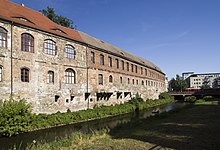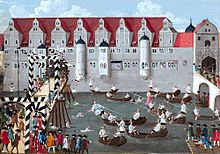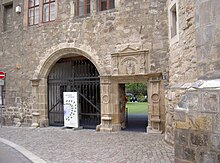New residence (hall)
From 1644 onwards, New Residence is the name given to the four-winged building complex built in 1531 as New Gebew in the city of Halle an der Saale . The imposing building erected by Cardinal Albrecht von Brandenburg is the result of the early importation of Italian Renaissance ideas and motifs into central and northern Germany and one of the most important early Renaissance buildings in Germany . It is an unpaved building complex with residential character and formerly a close connection to an elaborate garden on the other side of the city wall.
Thesis about founding a university
The thesis is put forward that the building was built for a new university in Halle. This thesis must be considered a minority position, as it is largely rejected in current research. According to her, Cardinal Albrecht von Brandenburg, Archbishop of Magdeburg and Mainz, Administrator of Halberstadt, summed up at a time in which university education in Germany had been in constant decline since around 1510 (the enrollment numbers fell nationwide in some cases to a quarter) , Margrave of Brandenburg and Arch Chancellor of the Holy Roman Empire of the German Nation and thus the second most powerful man after Emperor Charles V , decided to found a Catholic humanistic university in Halle.
In his Apologia , the famous humanist and Erfurt University Rector Crotus Rubeanus (* 1480 - † 1545) describes Albrecht's motives for founding the university: “Fatherly benevolence towards the younger generation made him do this; for one sees the youth only chasing after the profit, while the studies are completely neglected. Albrecht wants to prevent this, like a good farmer who plants a tree whose fruits will only be harvested by the next generation. ” After the Brandenburg University of Frankfurt in 1506, the University of Halle was his second university establishment.
Albrecht's activities are understandable from his humanistic background: As one of the leading representatives of the humanistic movement, the science enthusiast Albrecht von Brandenburg, in close contact with great humanists such as Ulrich von Hutten and Erasmus von Rotterdam , acted as a vehement promoter and advocate of science. His humanistic and reform Catholic approaches failed, as did those of his fellow campaigner Erasmus von Rotterdam, but largely because of the increasing polarization of Catholicism and Reformation , but also because of the progressive deterioration in the economic situation of the cardinal himself.
The first university in Halle developed from the Neue Stift zu Halle, which was also founded by Albrecht in 1520 - a reformed collegiate institution for the special care of the sciences and culture. Already in this progressive institution he implemented essential educational and religious reform approaches and made the city of Halle the educational center of the archdiocese. The monastery was in charge of the scientific education in the Archdiocese of Magdeburg (exercise of the archdeaconate and school rights in the archbishopric).
Albrecht drew up the plan to expand the New Abbey into the “most modern German university based on the model of Bologna ” in the early 1520s. He also used the young Wittenberg University of Frederick the Wise as a model for organization and development , which maintained a close connection between the monastery and the university.
On May 27, 1531 Albrecht received the papal privilege to found the university, combined with the promise to use the goods of the wealthy Neuwerk monastery to finance the university. In the same year he appointed important theologians as canons and founding professors of the university in Halle.
At the same time as the construction work at the Catholic university, the university began operating in the spring of 1531, initially in the rooms of the neighboring collegiate monastery , and gradually in the completed rooms of the residence. As the first university chancellor, the former acted provost of the New pin Michael Vehe . Prominent personalities such as the great humanist Johannes Crotus Rubeanus, co-author of the famous letters to the dark men , taught as professors . The university housed the faculties of law, theology, medicine and philosophy. The fact that the university was an extension of the New Abbey also explains the simple designation of the ensemble in Albrecht's time as "New Building" (New Gebew) in contrast to the "Old Building" of the Abbey.
The Albrechtsche University housed two Europe-wide famous libraries with extremely valuable holdings in the north wing: The university library was created in 1538 through the integration of the extensive monastery library, through the takeover of holdings from dissolved Halle monasteries and through own acquisitions. The cardinal's private library, the so-called "liberey" , which was also available to the students, contained, in addition to splendid gems of early book printing, extremely valuable books by Latin and Greek authors on all areas of knowledge.
Albrecht's great enthusiasm for science also arose from his spectacular scientific collections of mineral-geological, geographical, ethnological and historical objects, which were housed in the 68 m long Great Gallery of the east wing. These early collections were still a rare novelty in the 16th century and at the same time established the tradition of the Residenz, which continues to this day, as a location for valuable scientific collections.
In accordance with his humanistic ideals, Albrecht lived in the New Residence as a “scholar among scholars” , as he did before in the Neues Stift .
history
Building history
In 1530/31, Albrecht had the city's Cyriakus Hospital torn down immediately south of Halle Cathedral , on the bank of an arm of the hall , and had the Johannishospital completed by 1530. The New Residence began in 1531. Hans von Schönitz (Schenitz) worked as a building manager and perhaps also as the draftsman until September 1534 , from May 1533 to 1537 , Andreas Günther († 1541), was the architect (master builder) of the archbishopric of Mainz and Magdeburg and the diocese of Halberstadt, provable, from May 1537 Bastian Binder. In that year the north wing with the chapel was built, and construction is said to have been completed in 1538. The building material came from the abandoned Neuwerkstift and the old Ulrichskirche. The old hand-cut stones can still be seen today.
Residence of the archbishops and administrators
In the following period from 1545 the archbishops of the Magdeburg archbishopric resided in the new residence , later also secular administrators , especially after the neighboring Moritzburg had largely become ruin in the Thirty Years' War in 1637/39.
The new residence experienced its last great heyday from 1644 to 1680 through the music and art-loving Duke August von Sachsen-Weißenfels , who also gave it the name “New Residence” , in contrast to the “Old Residence” located just a few meters to the east . August developed an extremely splendid court and helped the city of Halle to a last great economic and cultural boom after Cardinal Albrecht's heyday. Among other things, the Neue Residenz became the traditional venue for the first German opera in the early Baroque and Halle became the leading opera city. After his death, the archbishopric and with it the city of Halle came to the Electorate of Brandenburg in accordance with the provisions of the Peace of Westphalia .
Renewed use by the New University
In 1694 the university was again founded in Halle, this time under Protestant flags. In his founding privilege, the then sovereign, Elector Friedrich III. , proud of his famous family member, Cardinal Albrecht von Brandenburg , who founded a university in Halle in 1531.
For this newly founded Friedrichs University (Fridericiana) , too , the Neue Residenz acted as the nucleus and first accommodation of the most valuable and comprehensive university collections on a European scale, trend-setting scientific institutions and important scientific societies. In 1735 all faculties, law, medicine, theology and philosophy had already found their domicile in the residence.
The new residence experienced a drastic expansion of university use from 1785 at the latest in the wake of the activities of the active university chancellor Carl Christoph von Hoffmann . On the decree of King Friedrich Wilhelm, extensive construction work began in 1789, which tragically resulted in the total loss of almost all historical elements of the most valuable building of the Central German Early Renaissance such as dwelling houses, round gables, arcades, Mühlgrabenbrücke, spiral stones, oriels, etc. After the construction work was completed, the anatomical theater with a dissecting room, the natural history cabinet of Johann Friedrich Gottlieb Goldhagen and a natural history auditorium moved into the upper floor of the north-west wing. A chemical laboratory found its home on the first floor.
In 1808 the first Prussian maternity hospital including a midwifery school was set up on the upper floor of the east wing under the direction of Carl Friedrich Senff "for the benefit of students and young doctors" . When the Westphalian State University of Rinteln was dissolved , its mineralogical-geological collection was also moved to the east wing. The surgical clinic under Johann Friedrich Meckel moved to the south and south west wing. From 1809 to 1935 the university-related natural research society took up residence, which included famous international luminaries such as Jean-Baptiste de Lamarck , Johann Wolfgang von Goethe , Georges Cuvier , Alexander von Humboldt , Michael Faraday and Justus von Liebig as members.
The famous Meckel collection was also brought to the residence in 1841. Finally, 1873 is the founding year of the Mineralogical Institute and Museum and in 1884 the Museum of History and Archeology of the Province of Saxony opened its doors on the ground floor of the east wing as a successor to the Antiquities Association .
Recent history
One of the last stages in the history of the university residence was the opening of the Geiseltal Museum in the residence chapel of All Saints in 1934 . During the GDR era , the new residence was home to the geography section of Martin Luther University and the Geiseltal Museum. From the Geography section, the Geosciences Department was founded in 1991 with seminar, laboratory and office rooms in the entire north and west wing. The 475-year history of the university's residency ended in 2003 when most of this department moved to the weinberg campus . The Geiseltalmuseum was closed to the public for several years, but has been open to the public again in its old location since May 2018. The Geiseltalsammlung is to this day (as of December 2018) in the rooms of the New Residence.
In 2003 the Neue Residenz eV was founded. The main goal of the non-profit association is to help the Neue Residenz gain greater awareness as a historical and identity-bearing place in the city of Halle. To this end, the structural substance of the New Residence is to be renovated and gradually brought to the general public as a lively home for cultural, scientific and economic encounters and education. On the basis of a comprehensive utilization, marketing and redevelopment concept, the association has started to implement these goals and the polyvalent management. Thematic tours are offered, among other things. However, the state of Saxony-Anhalt continues to run the building complex as a sales property in its real estate portfolio.
description
Alongside the Moritzburg, the Neue Residenz is one of the most magnificent secular buildings of the early Renaissance in Halle. The Neue Residenz is the result of an early import of Italian Renaissance forms into central and northern Germany. The four-wing complex, built over an irregular square, is located next to the Halle Cathedral and in the south met the Klaustor, which no longer exists today. The Mühlgraben, an arm of the Saale, flows on the west side.
The originally plastered quarry stone buildings were provided with a wreath of high dwelling houses on all sides and, like the cathedral, with French gables . The side of the hall is divided into a sequence of four oriels spanning several floors . The east wing opened onto the courtyard on the ground floor as a 68-meter-long hall with central pillars and arcades ; the space above served as a gallery.
The flat arched arcades of the inner courtyard, supported by sturdy Tuscan columns, are largely blocked today, the dormers with round arch attachments have been removed. On the north side, parallel to the cathedral, is the "All Saints" chapel, completed in 1539 . It is a typical transition building from the Gothic to the Renaissance . The round buttresses and the rectangular windows are considered an attempt to create new pre-Gothic, i. H. to find ancient forms. The arcade from the chapel to the cathedral is still partially preserved. A large late Renaissance portal was added in the east wing. In addition, two Romanesque columns and a Romanesque portal in the north wing of the Neuwerk monastery, which was demolished in 1531 , were installed in this part . They are excellent works from around 1180/1200.
Conversions in the late 18th and 19th centuries, combined with a sharp reduction in structural shapes, cut the Neue Residenz into a kind of shell. The representative front of the hall lost its characteristic gable, bay windows and balconies. The girders and supports can still be seen in the masonry today.
The roof was renewed between 1988 and 1993, but the building needs a lot of renovation.
patio
In the 1500 m² inner courtyard of the Neue Residenz, a garden landscape on a specific topic has been created annually since 2009 by the Halle-Saalkreis professional training organization in cooperation with the Halle (Saale) job center and around 30 long-term unemployed people. The themes in 2009 were: Baroque garden, 2010: water games - living water, 2011: rose garden, 2012: Italian landscape garden, 2013: art garden and 2014: courtly pleasure garden. There is a café that sells homemade cakes, sponsored by Halle's bakeries. The proceeds will be donated to charitable organizations of the city of Halle. This garden is open from May 31 to August 31, daily from 10 a.m. to 10 p.m. Admission is free.
literature
- Hans-Joachim Krause: The Moritzburg and the "new construction" in Halle. in: Andreas Tacke : Continuity and caesura Ernst von Wettin and Albrecht von Brandenburg. Wallstein-Verlag, Göttingen 2005. ISBN 3-89244-955-4 .
- Hans-Joachim Krause: The new building for Cardinal Albrecht von Brandenburg in Halle. in: Stefanie Lieb (Ed.): Form and Style. Festschrift for Günther Binding for his 65th birthday. Darmstadt 2001, pp. 213-223.
- Ute Bednartz: Dehio - manual of the German art monuments. The administrative districts of Dessau and Halle. Kunstverlag, Munich & Berlin 1999. ISBN 3-422-03065-4 .
- Holger Brülls / Thomas Dietsch: Architectural Guide Halle on the Saale . Dietrich Reimer, Berlin 2000. ISBN 3-496-01202-1 .
- Paul Redlich: Cardinal Albrecht von Brandenburg and the New Abbey in Halle 1520 to 1541. A study of the history of churches and art. Mainz 1900.
- Ulrich Taschow: The New Residence. Yesterday - Today - Tomorrow , in: scientia hallensis , Halle 2006. 1/06; P. 12f., 2/06, p. 26f.
- Matthias Müller: Residence architecture without residence tradition. A comparative evaluation of the residential architecture of Albrecht von Brandenburg in Halle under the aspect of historical viability. in: Andreas Tacke (Ed.): The Cardinal. Albrecht of Brandenburg, Renaissance prince and patron. 2 vol. Regensburg 2006, pp. 169–179.
- Stephan Hoppe : Romanesque as antiquity and the structural consequences. Conjecture about a forgotten discourse. in: Norbert Nussbaum; Claudia Euskirchen; Stephan Hoppe (ed.): Ways to the Renaissance. Observations on the beginnings of the modern conception of art in the Rhineland and the neighboring areas around 1500. Cologne 2003, pp. 89–131, here pp. 110–115.
- Anke Neugebauer: Andreas Günther - court architect Cardinal Albrechts of Brandenburg . in: Castles and Palaces in Saxony-Anhalt 15. (2006) pp. 230–260.
Web links
- former homepage Neue Residenz e. V. ( Memento of January 2, 2008 in the Internet Archive ) (as of January 2, 2008) with information, images on the past and present of the New Residence
- Article on the university history of the Neue Residenz: Part 1 (PDF; 1.21 MB), Part 2 (PDF; 1.62 MB)
Individual evidence
- ↑ Website of the central magazine for natural science collections at the University of Halle on December 20, 2018
- ↑ Regional on Radio corax on June 30, 2015
- ↑ Lustgarten - Gartenlust ( Memento from August 4, 2014 in the Internet Archive )
- ↑ The new residence becomes a pleasure garden: the garden oasis opens on Saturday ( Memento from August 9, 2014 in the Internet Archive )
Coordinates: 51 ° 29 ′ 0.8 ″ N , 11 ° 57 ′ 51.5 ″ E





